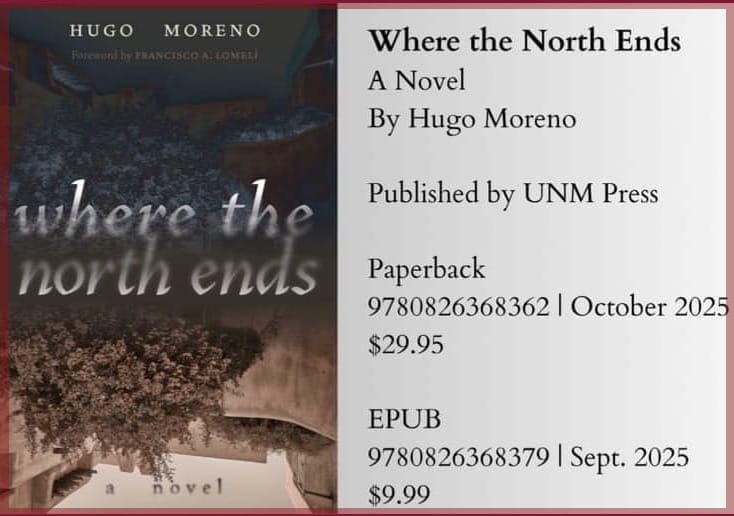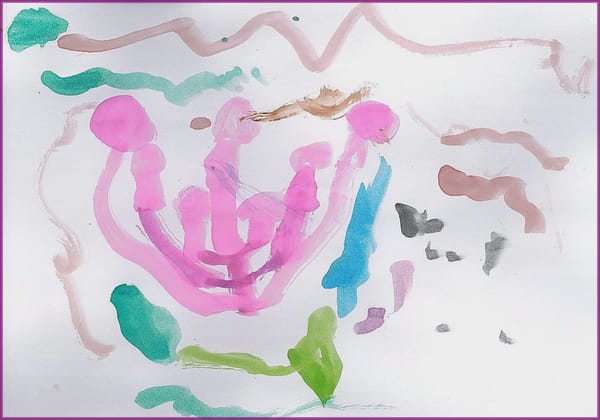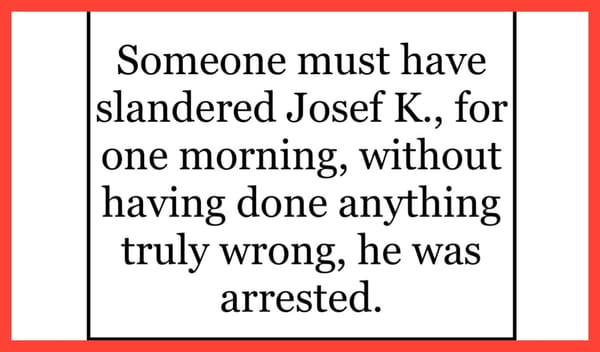As Wagner's German opera house addresses his antisemitism, one of his most famous works is coming to the Santa Fe Opera this summer.
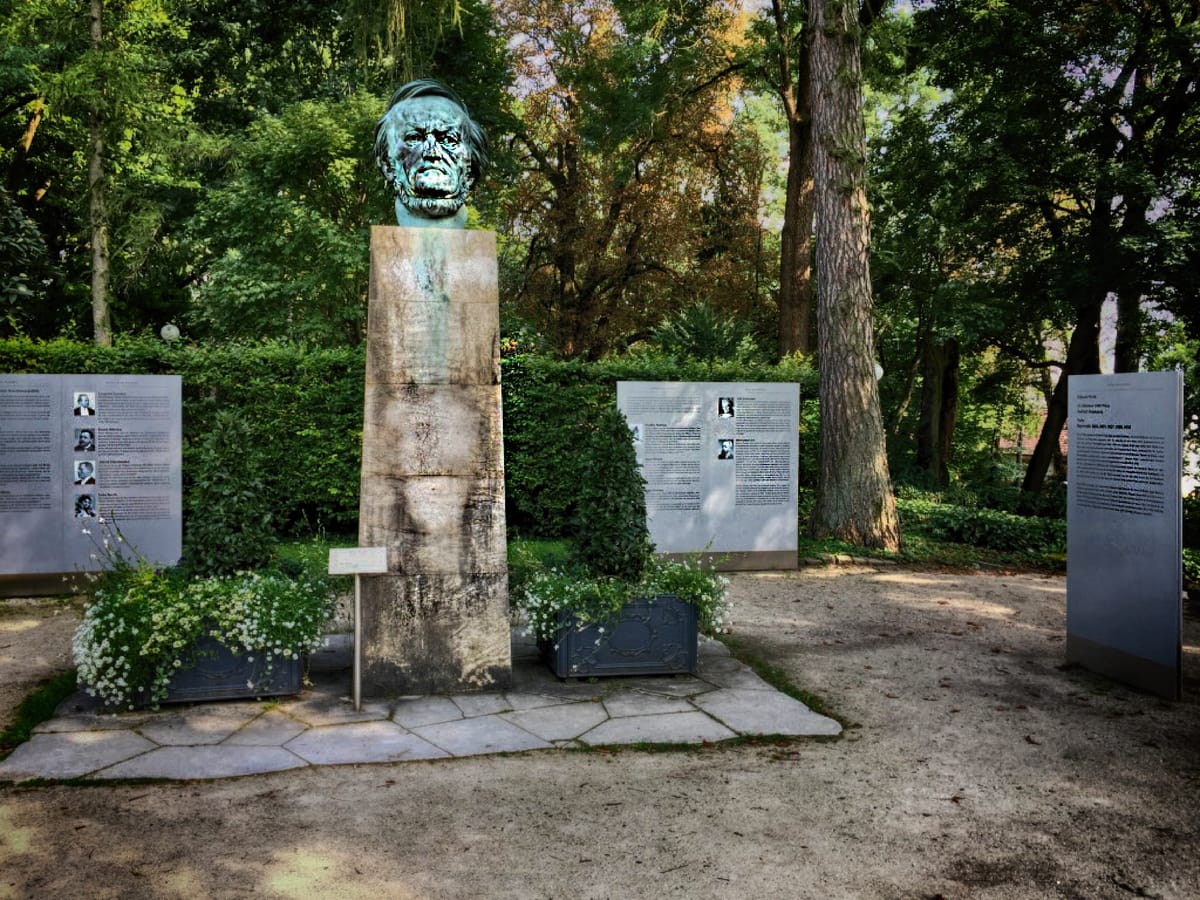
By Judith Fein
Photos by Paul Ross
About ten years ago, a fellow opera lover gave me a DVD of Richard Wagner’s Ring Cycle. I had little interest in the German composer (1813-1883) who I was told was a pretty awful human being. He milked his friends like cash cows, carried on with their wives, lived high on the hog and was foppish in dress, having his benefactors pay for his pink and green silks and magnificent lodgings. He was also a rabid antisemite and published a despicably racist and ugly essay about Judaism in music (“Judentum in der Musik”) in which he trashed Jews as being hideous, talentless, incapable of excelling in the art, and inferior in every way. The only one in his entourage arguably more antisemitic than he was his second wife, Cosima, the daughter of Franz Liszt.
So, it was with a mixture of hostility and indifference that I listened to the first notes of The Ring Cycle, an epic saga of gods, giants, heroes, dwarves, greed, love, warriors, water nymphs, magic, swords, sacrifice, punishment, innocence, power, and destruction.
The musical opening is the creation of the Rhine River. It begins with low tones, like something emerging or being born in a state of wonder and innocence. And it rapidly morphs into movement and complexity, and is so dazzling that I held my breath as life appeared and flourished and I was overcome by the most brilliant music I had ever heard.
A few years later, my husband Paul and I flew to Bayreuth, Germany, where we were given tickets to the much-sought-after Ring Cycle performance (at the time, it took an average of l0 years to score a ticket). The length of the entire Ring Cycle, spread over four nights, was about l8 hours. The elaborate musical theatre event takes place in the summer at the 1876 opera house that Wagner built specifically for performances of the Ring and it attracts a very cultured, sophisticated global audience.
We heard that Jews are some of the most avid Wagner fans, and the ones we met said they find Wagner’s antisemitism troubling. Like me, they asked themselves how such a musical and theatrical genius could have been such a vile homo sapiens specimen. Maybe the works he created embodied the beauty, grace, and humanity that eluded him in life. Or maybe there just is no answer.
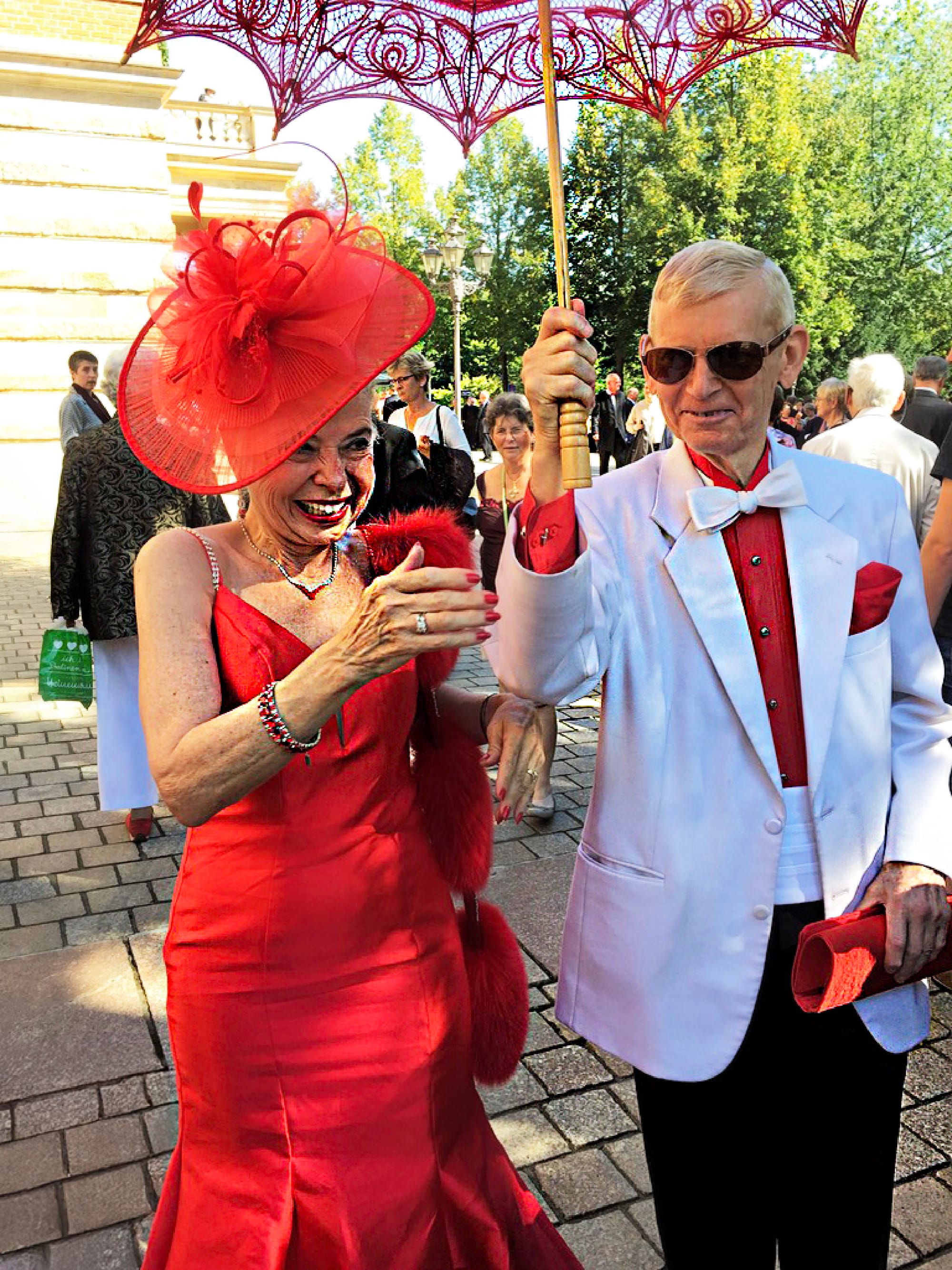
Before going to Bayreuth, Wagner fans and Wagner Society members I met made light of his antisemitism. In my personal experience, they deflected questions, or lightheartedly cited a few Jews he worked with, and if there was a big Wagner rug, the uncomfortable issue was swept under it.
But the day we arrived I was shocked to find out that the antisemitism rug was gone. We climbed the verdant hill to the famous Festspielhaus where the festival performances were first held under the watchful eye and direction of Wagner himself and are still held today.
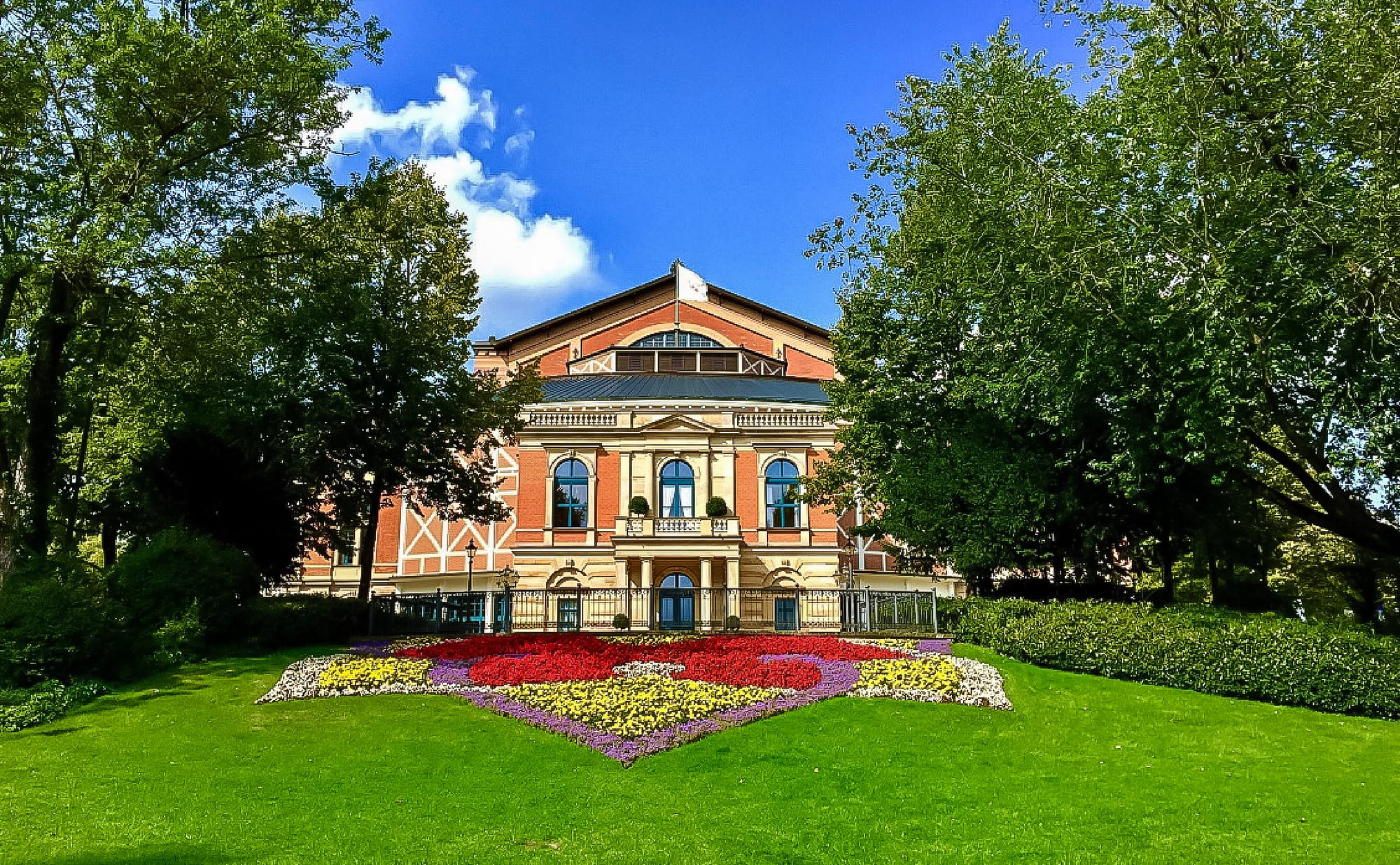
Directly below the hilltop theatre, in a large, two-tiered garden, was — and still is — a very explicit exhibit about Wagner’s antisemitism. It features prominent metal panels or stelae with pictures of Jews who were not allowed to sing, play music, or direct in the Wagner theater in Bayreuth, and tragic stories about what eventually happened to them. Some escaped, some died in concentration camps, and all of them were barred from practicing their craft. In some instances, they weren't even Jewish but were married to Jews, or they were only one fourth Jewish, but it didn't make a difference to their racist detractors. Wagner considered Jews to be evil and anti-cultural whereas the Germans were the bringers of light and culture.
Even more damning than the Wagner panels are the ones about Cosima. She established stringent rules after Wagner died, not allowing anyone of any Jewish persuasion to have anything to do with the opera except if he or she were already a big star. Later, the 1920’s, members of Wagner’s family became friendly with Hitler and the Nazis and turned the festival into a Nazi showcase, which Hitler, an ardent Wagner fan, attended. Several authors have even suggested that the Wagner family’s writings and antisemitism helped to influence Hitler to discover “the final solution” to eliminate the Jews, but there is no definitive proof of this.
The exhibit was intended to be temporary, but there has been such support that it is now permanent, so you can see it whenever you visit Bayreuth.
I was overcome with a sense of how courageous the city of Bayreuth and the Wagner festival are for doing this. Imagine if the White House had an extensive exhibit about our slave-owning Presidents, or innocent blacks who were murdered, or the decimation of Native Americans.
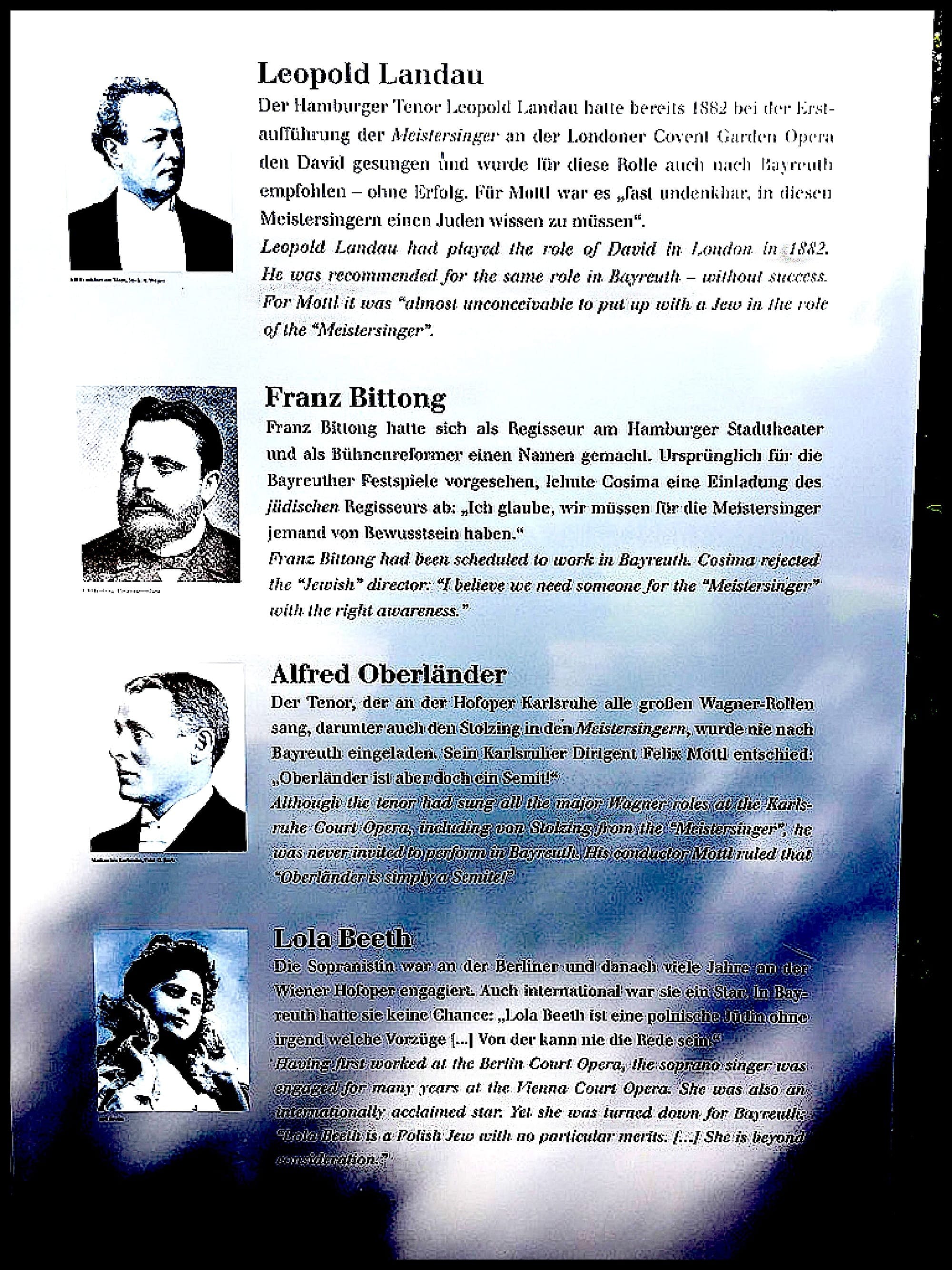
But the exhibit was not the only unexpected find in Bayreuth; the other occurred when we met Felix Gothart, the affable, knowledgeable leader of the Bayreuth Jewish community. He was a tall, fit, gray-haired man, who was sporting a kippah, jeans, and black shades. He said the community had several hundred members, most of whom arrived from Russia after the fall of Communism in l991. He proudly stated his Jewish creds: his grandfather was the leader of the Mizrahi (religious Zionist) party in Poland, and his mother was a distant relation to a Ger (Hasidic dynasty) rabbi. Both parents participated in the Warsaw uprising, and were survivors of concentration and death camps.
After World War II, Gothart continued, “About 350 DP’s (displaced persons) came here, and in the surrounding areas there were kibbutzim. One of them was preparing for the Irgun (a Zionist paramilitary organization) and it was kept secret from the English … Some former inhabitants of Bayreuth also returned. If they found the new owners, they got their houses back.”
Gothart’s father started a kibbutz, and also brought back Jewish activity after the war. By 1946 they were praying in the synagogue, which miraculously survived the war. The Nazis were afraid to burn down the famous 1748 Baroque opera house next door to the synagogue. In 1759 the opera house was sold to a Jewish family, who opened an adjacent synagogue there in 1760. When the German army refused to surrender at the end of WWII, the American Air Force bombed most of the city, except for the synagogue and opera house. “So,” Gothart explained, “some people say the Opera House [now a UNESCO World Heritage site] protected the Synagogue and at the end of the war the Synagogue protected the Opera House. Today it’s the oldest working synagogue in Germany that’s still in use.”
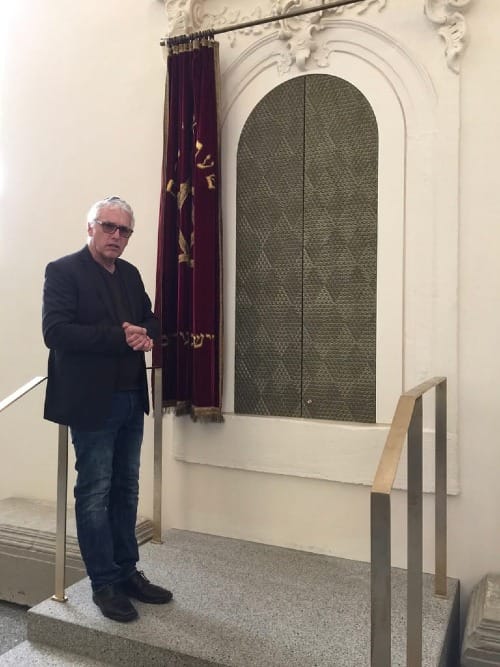
Gothart offered to take us on a tour of the synagogue, which was closed for restoration. He excitedly led us upstairs to the attic, where, under the floorboards, he found a geniza that dates back to the 16th century.
A geniza is a sort of resting place for Jewish books and papers. If any of them are old or damaged and they include the name of God they cannot be discarded. They must be buried and allowed to disintegrate back into the earth. The trove Gothart discovered included an astounding 8000 pieces of paper and parts of books. Among them were kabbalistic writings women carried to protect their pregnancies; part of a book that predates the Shulchan Aruch (the code of Jewish law); a document wrapped in l8th century lottery paper; and a paper from l567 that is the oldest object ever found in a German geniza.
According to Gothart, the first recorded Jewish presence in Bayreuth goes back to the mid 13th century, and during successive centuries there were periods of banning and grave restrictions on the Jews, and periods of relative calm. The Nazis occupied Bayreuth, stole 28 torahs and religious items, smashed the inside of the synagogue by hand, crept all over the roof and inside the synagogue, but never discovered the geniza.
Gothart said that in opera times, the nobles sat upstairs and the stage and regular folks were downstairs. It was perfect for a synagogue. The upstairs is now for women and the downstairs is a small, modern sanctuary.
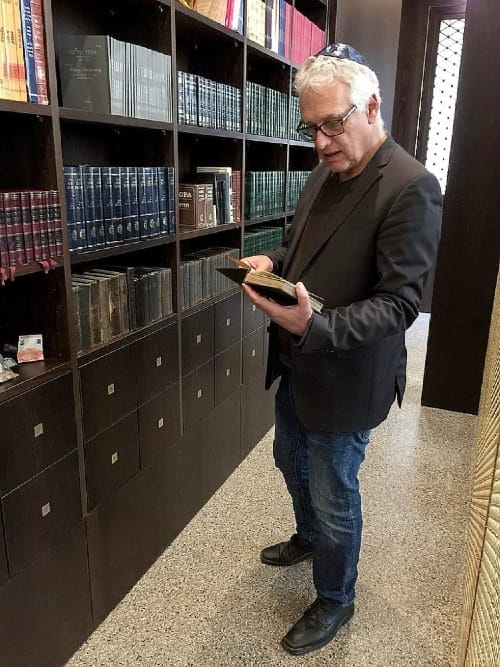
We left the building, and Gothart drove us to the Jewish cemetery, about l0 minutes away. It was like entering an enchanted forest of the dead, carpeted in green plants, silent, atmospheric. Three stones stand as witnesses to those who died in both world wars, with the addition of an evocative, mystical quote from Ezekiel: “I blow my spirit into you, and you will be alive.”
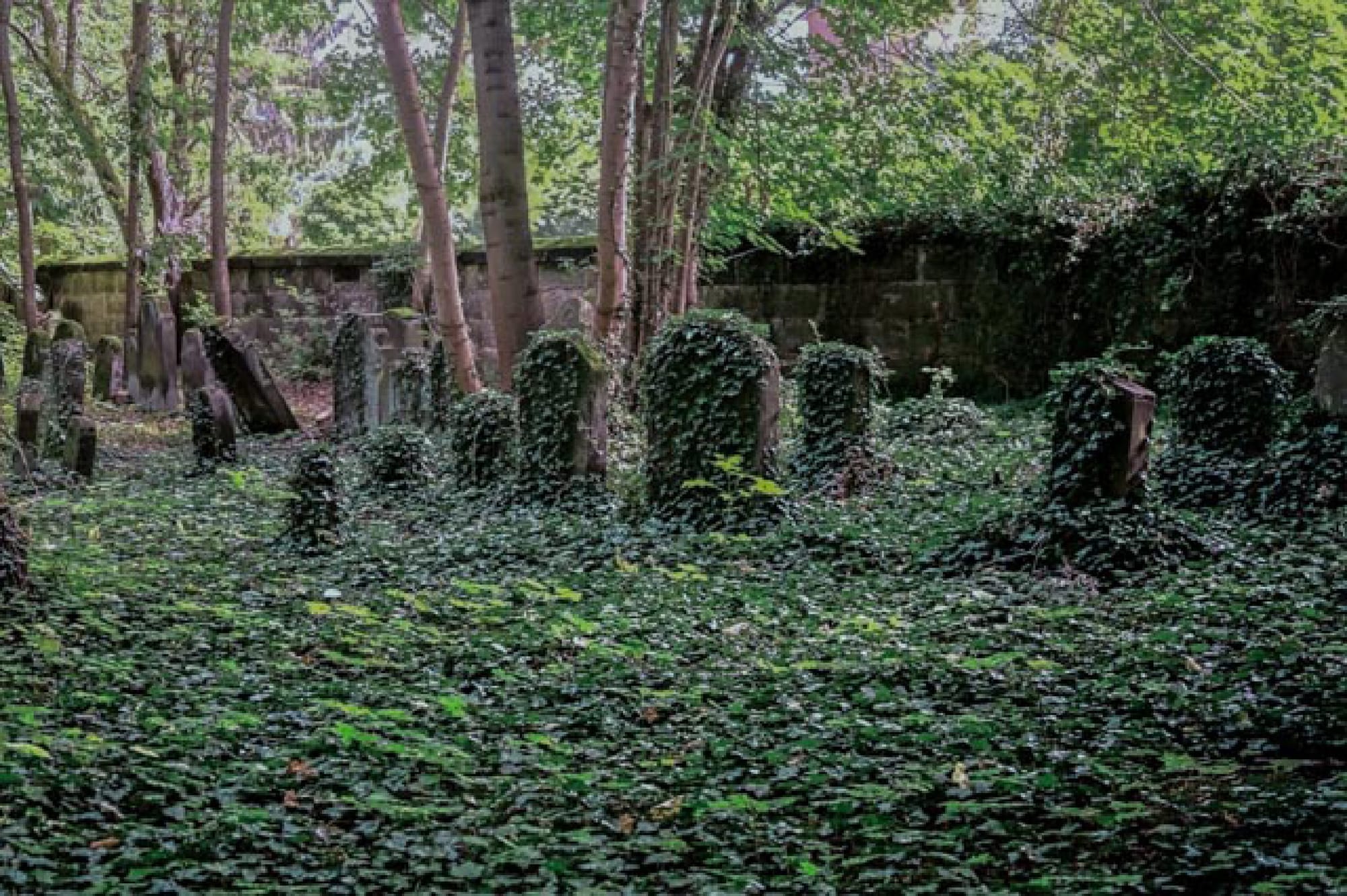
The cemetery, which dates back to 1788, was closed to the public, and Gothart said he only takes people there once a year, on November 9, to commemorate Kristallnacht. “The Nazis started removing headstones here, and then stopped. No one knows why. There are about 1000 stones.” He very simply, and movingly, explained that, “All the clearing and cleaning in the cemetery is done by hand. There are no machines inside the walls. Once a year, a machine comes outside the wall and takes what we have cleaned up in the cemetery. They reduce it to mulch, which is then returned to the cemetery. So, nothing is removed. This place belongs to the dead. I don’t want people to come here to disturb them.”
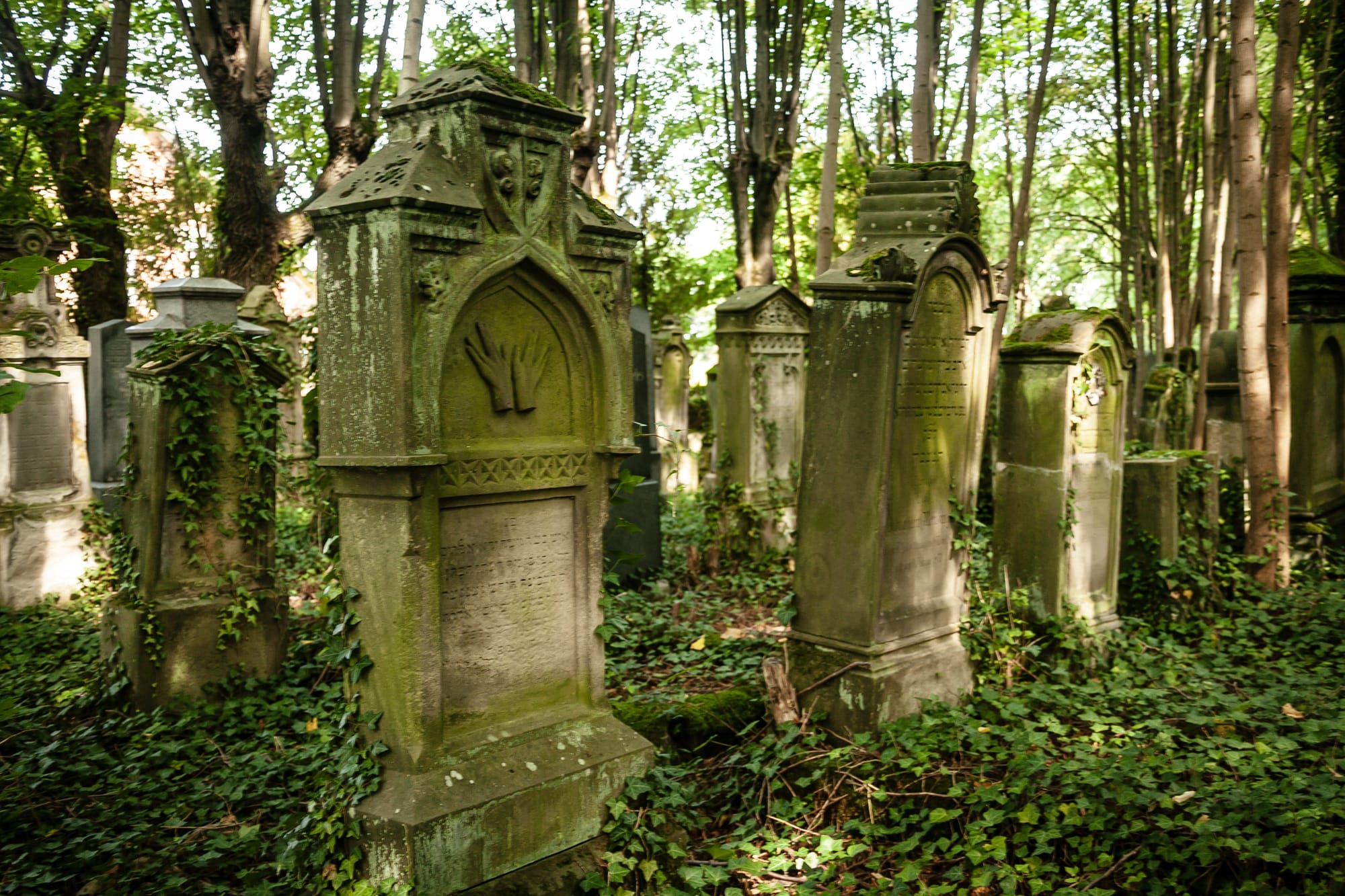
The cemetery wall is made of commemorative stones for those who died in camps. “There are no headstones for them,” Gothart said, “because there are no bodies. The dead here have no descendants.”
We walked past a headstone that Gothart pointed out; it belongs to Josef Rubinstein. He was a great admirer of Wagner, and wrote to him to explain that he came from a wealthy Jewish family, was a pianist, transcribed musical scores, and wanted to work for the maestro. Not one to turn down the lure of someone independently wealthy who could work for him for free, Wagner agreed. Rubinstein became his personal pianist and transcriber and, by some accounts, was treated poorly. Yet, when Rubinstein heard that Wagner had died, he killed himself. Inexplicably, because Cosima was such a rabid antisemite, she had his body brought to the Jewish cemetery.
I recently reconnected with Gothart by email, and he gave me an update on the congregation. The synagogue now has about 400 members, and the reconstruction, which took years, is finally complete. They will be able to offer bedrooms for guests and kosher meals on demand. The cemetery is currently open to everyone who wants to visit if they make their request in advance. “It's not open to the public. The peace of the deceased should be protected,” Gothart wrote.
And when I asked him if he was attending performances at the Festspielhaus, his answer was searing and poignant. “Personally, I am not going to the Festspielhaus to listen to Wagner. If you read Wagner's "Judentum in der Musik" and if you know that his music was played at the selections on the ramp in Auschwitz it is difficult for me to enjoy his music as art.”
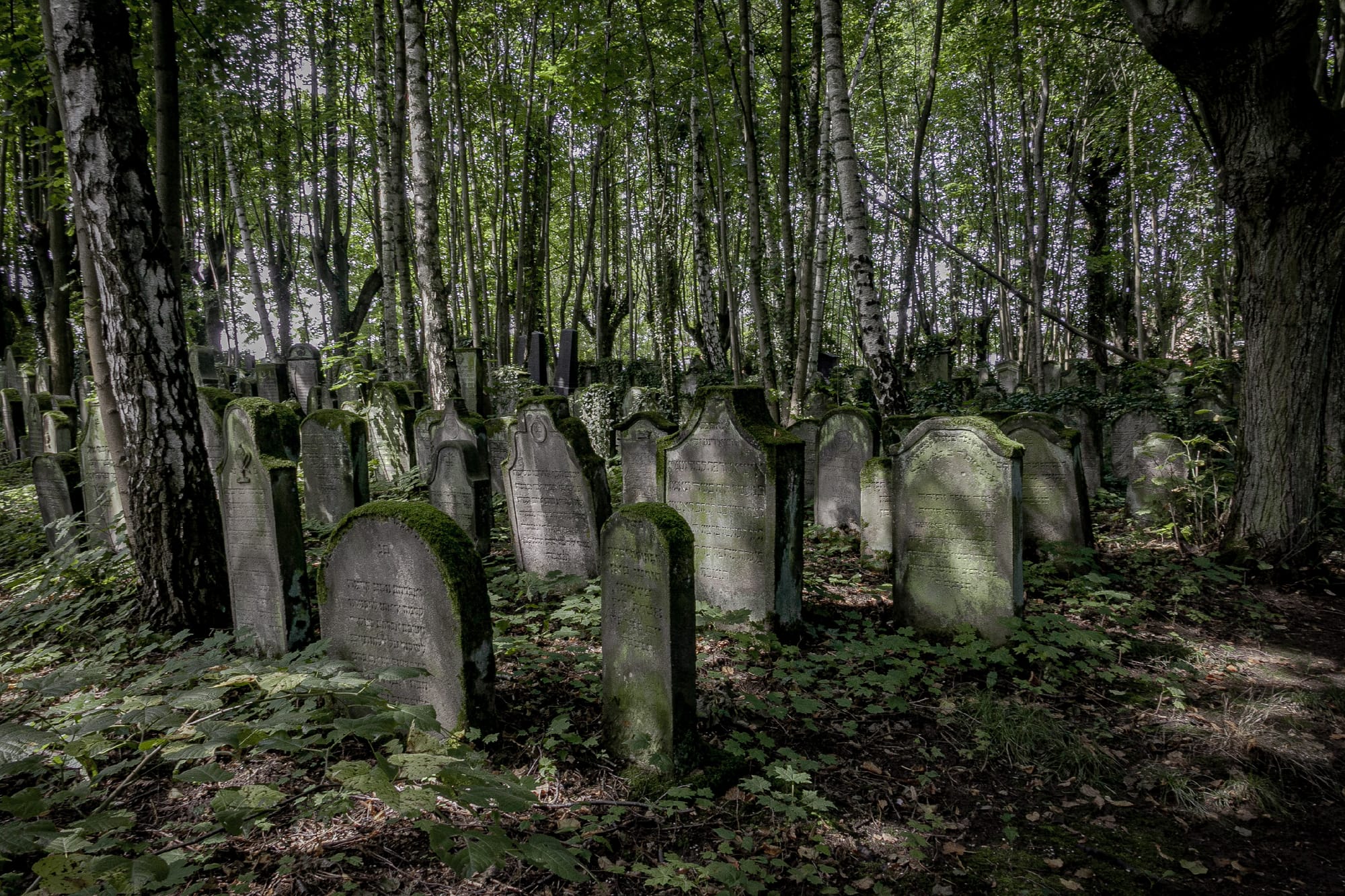
Before writing this article, I wanted to find out more about the startling exhibition in the park below the Festspeilhaus, and I was fortunate to connect to Dr. Sven Friedrich, director of the Richard Wagner Museum in Bayreuth.
“The exhibition was shown in its entirety in 2012 and 2013. In September 2015, the Bayreuth City Council decided, following my suggestion, to preserve the local section with the steles that were already permanently mounted in the ground as a documentation site, as dismantling them would have been relatively costly and there was no reason not to leave them in place – quite the contrary.”
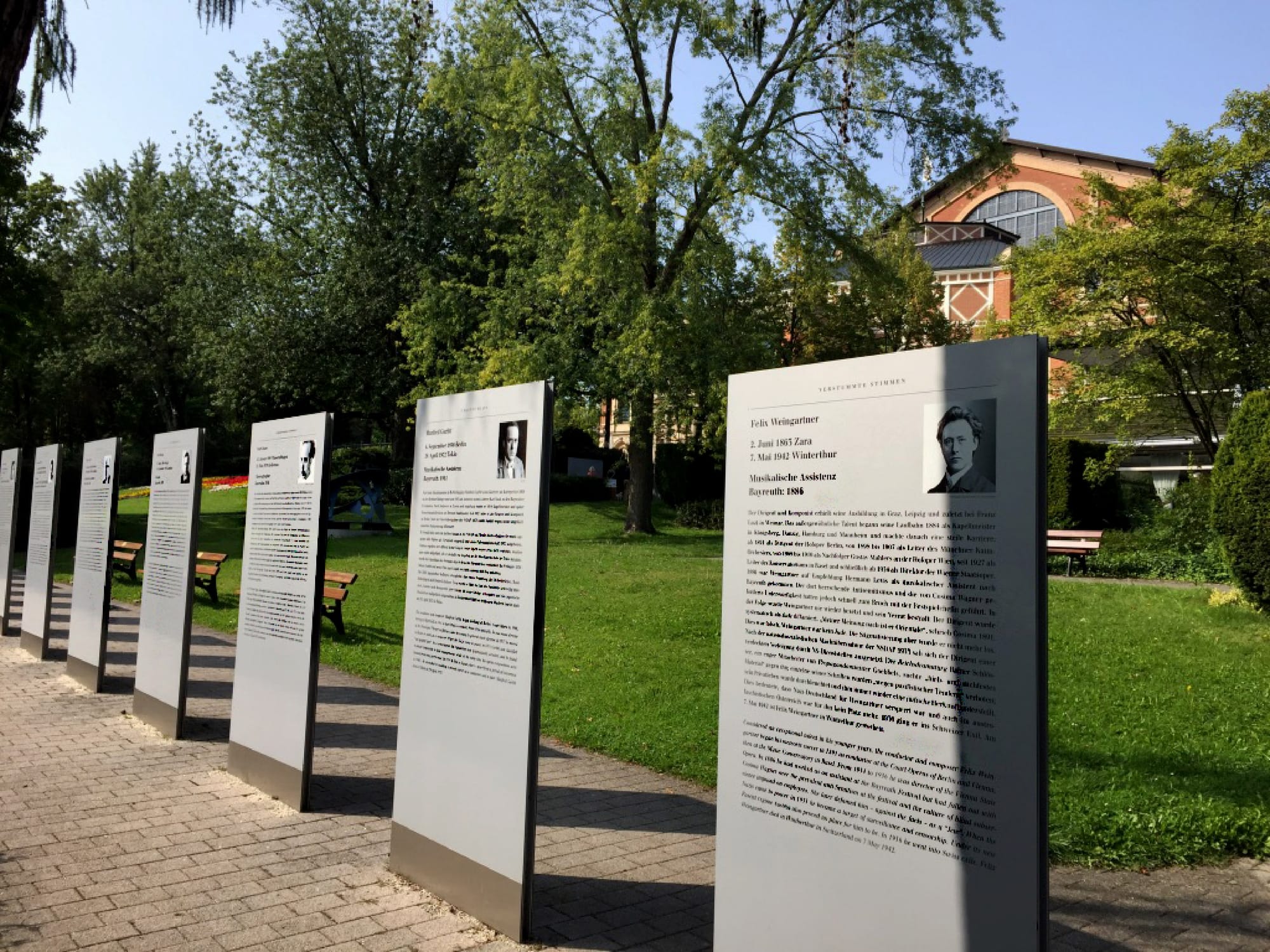
When I told him we had seen the burial place of Josef Rubinstein at the cemetery, he told me a remarkable story. On 7 March 1872, Wagner received a first letter from Rubinstein in which he introduced himself:
"I am a Jew – that says it all. I possess all the characteristics that are remarkable in the Jews of today: I dragged myself through life in complete despondency and almost shameful weakness. Then circumstances brought your works to my attention… But the happiest time of my life, the time I spent studying those works, is now over. All that remains for me is death! I have already tried to take my own life, but I decided to write to you first. Perhaps you could help me. I do not, of course, mean help out of mere pity… No! But could I not be of use to you in the performance of The Nibelungen? I believe I understand this work, even if not yet perfectly. I expect help from you, and help that is urgently needed. My parents are rich. I would have the means to travel to you immediately. I await your reply as soon as possible."
After Wagner's death, he no longer saw any point in living and tragically shot himself in the park at Tribschen on 22 August 1884. Cosima Wagner had his body transferred to Bayreuth and buried there.
“Shabbat shalom!” Mr. Friedrich concluded his letter.
Wagner’s relationship with Josef Rubinstein was one of numerous complexities and contradictions in Wagner’s life and character. Surprisingly, he was very influenced by Buddhist ideas. He was also a vegetarian in theory, although he didn’t strictly avoid animal products. He didn’t refer to his works as “operas.” He was wildly progressive in his creation of what he called “music drama” — theatrical experiences where the music served the drama.
So, should you consider going to the Santa Fe Opera this summer to see Die Walkür this summer? My vote is yes, yes, yes. For me, Bayreuth and its recognition of the complexity of Wagner including the very dark side of his person makes it possible to reject his behavior and open your eyes, ears, and heart to the incomparable magnificence of a creative — though admittedly flawed — genius.
In my next piece, I’ll be writing about Die Walkür as a reflection of Wagner’s complexity after seeing the performance. Read in the NMJJ in August.
IF YOU GO:
The opera lasts about four and a half hours, with two intermissions. There is an all-day Wagner workshop with top experts at SFO on July 28, call for information.
https://www.santafeopera.org/whats-on/die-walkure-2025/
For more information, contact the Box Office.
800-280-4654
505-986-5900
boxoffice@santafeopera.org
For more information about the Jewish community in Bayreuth: ikgbayreuth.de
When you click on the site, look for the German to English google translate bar.
Please visit the New Mexico Jewish Journal and choose the subscribe button to sign up, and choose a subscription level from free on up. When you sign up you receive monthly emails of our newest stories, including Judith Fein's next article, after she attends "Die Walküre," The Valkyrie, at the Santa Fe Opera House opening night in late July. It is the second opera in Richard Wagner's Ring Cycle. Choose the subscribe button or go here to sign up: https://www.nmjewishjournal.com/about/#/portal
Judith Fein and Paul Ross have contributed articles and photos to more than 130 international publications, and are author/photographer for the recently released, award-winning experiential travel book SLOW TRAVEL NEW MEXICO: Unforgettable Personal Experiences in the Land of Enchantment. Judith is a popular speaker, opera librettist, playwright, former Hollywood screenwriter, and author of the books LIFE IS A TRIP; THE SPOON FROM MINKOWITZ; and HOW TO COMMUNICATE WITH THE DEAD. Paul also performs as PJ, a highly entertaining cowboy poet who has recently added a kosher cowboy poem to his repertoire. Learn more at https://www.Globaladventure.us
SIGN UP Please visit the New Mexico Jewish Journal and choose the subscribe button to select a level from free on up. You will receive monthly emails of our newest stories, including Judith Fein's review of "Die Walküre," following the Santa Fe Opera's opening night in late July.
The New Mexico Jewish Journal is an independent, online publication to connect the wildly diverse Jewish communities of New Mexico and beyond with news, arts, culture and spirituality. Founded March 2024 after the 55-year-old NM Jewish Link closed, it is supported only by the community's subscriptions, contributions, and charitable donations via our fiscal sponsor New Mexico Foundation, and grants. Donate, Subscribe, Contribute.
Awards: For our first nine months publishing in 2024, read we have just won top awards from the American Jewish Press Association, the Society of Professional Journalists, and New Mexico Press Women.
We are part of the New Mexico Local News Fund/Press Forward/Local Media Association Accelerator program to rebuild local news across the USA. #














